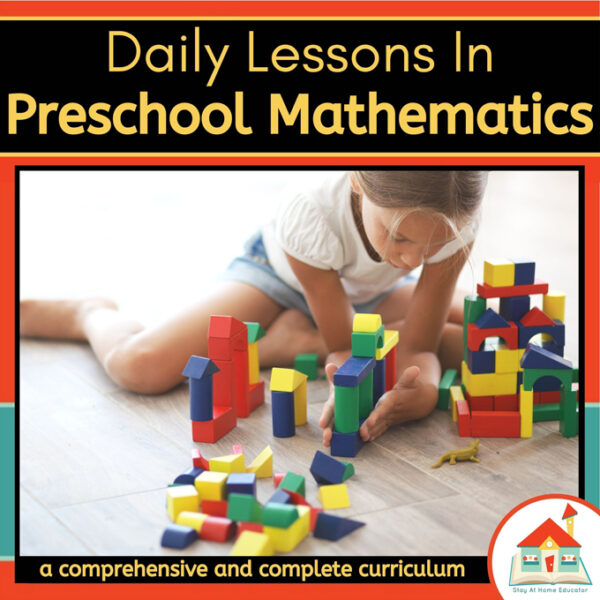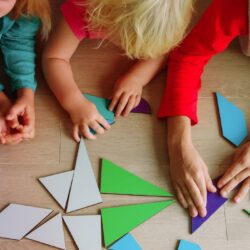Learning shapes is the most basic skill within the geometry discipline of math, so it makes sense that we spend some time teaching our preschoolers about shapes. But there’s more to shapes than just their names.
With hands-on and exciting activities, plus a detailed scope and sequence for the whole unit, these shape lesson plans for preschoolers this is one math skill that will be a breeze to plan for.
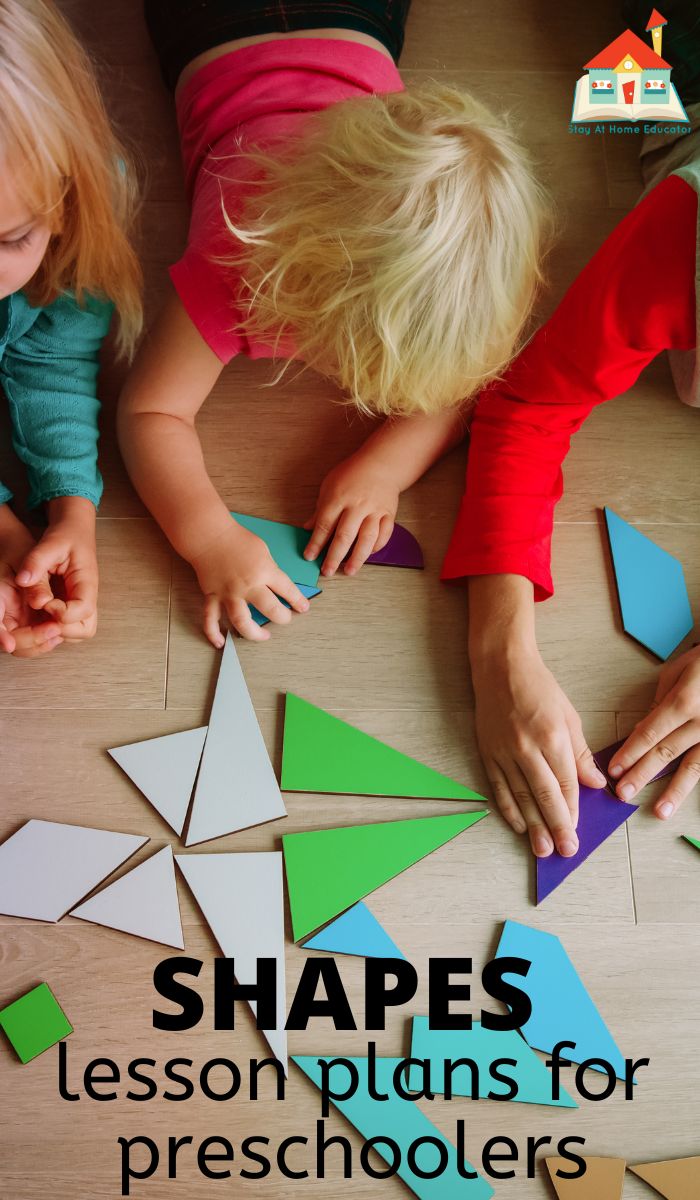
Understanding shapes is a fundamental concept in geometry, and it’s essential that we dedicate ample time to teach our little ones about these formative figures. Shapes are more than just names we memorize; they’re the building blocks of all the objects we see around us.
I knew it needed to spiral and review key concepts multiple times throughout the year, gradually increasing in difficulty. This approach is ideal because it covers math topics throughout the entire year. This allows children more time for mastery and an opportunity to increase the rigor of each lesson.
Our detailed lesson plans for teaching shapes to preschoolers provide a clear and well-structured scope and sequence, ensuring that educators have a comprehensive guide to follow.
Learning shapes helps children identify and organize visual information. Shapes encourage preschoolers to visualize and connect to the world around them. Learning shapes also helps children understand other signs and symbols, such as street signs or icons on a computer app.
These preschool or kindergarten shape lesson plans are perfect for helping you plan engaging and developmentally appropriate lessons and activities for your students without loads of prep and time.
Preschool Shape Activities & Lesson Plans
The Daily Lessons in Preschool Shapes Unit are bursting with engaging activities that not only introduce preschoolers to geometry and shapes but also encourage them to explore and discover the properties of these figures through interactive play.
Each day offers a variety of creative exercises designed to reinforce shape recognition and develop critical thinking skills in a fun, supportive environment.
Shapes Hands-On Supplies
This curriculum is designed to be low-prep and utilize the same supplies during each math unit. Buy it once, and use them over and over again for different learning purposes! Take a look at some of the resources we use for each unit. These items are staples for any early childhood math curriculum.
- 250-PIECE SET: Features 6 different shapes and colors, and is great for classroom activities
- RECOGNIZE PATTERNS: Get young students learning geometry and pattern design. These are great pattern…
- PARENT AND TEACHER GUIDE: Comes with storage bucket and not only helps educators and parents stay…
- LEARN 3D SHAPES — Includes 4 colors and 10 shapes: sphere, hemisphere, triangular prism, hexagonal…
- EQUIP CHILDREN WITH ESSENTIAL STEM SKILLS — These Mini Geo Solids will help kids to develop spatial…
- HANDS-ON LEARNING — These plastic blocks are great for sorting pattern recognition spatial…
- ATTRIBUTE BLOCK GEOMETRY SET: Our hand2mind attribute shapes make for fun sorting and easy clean up.
- GREAT FOR PRESCHOOL ACTIVITIES: Our attribute blocks help teach early learners sorting, matching,…
- EARLY MATH MANIPULATIVES: Attribute blocks are key math manipulatives for young students in…
- SO MANY SHAPES: Get 676 easy punch-out geometric shapes in assorted bright PRIMARY blue, yellow,…
- GREAT FOR INDEPENDENT LEARNING: Use the shapes for exciting and visual math lessons, counting,…
- EASY SEARCH AND STORAGE: 16 sheets organized by shape, size, and color makes it easy to find the…
All About Shapes Lesson Plans
These shape lesson plans for preschoolers are designed for up to a five-day-week program, but activities within a week can be removed and skipped for two or three-day-week programs.
There are lots of activities that develop shape recognition, learning shape attributes, and using pattern blocks to develop spatial awareness and learn to draw and create 2d shapes.
Discovery Activities/Math Photo Cards
The discovery activities are so much fun! Each week contains a real photograph or illustration for the children to interact with. The photo relates to the concept and encourages oral language development and math vocabulary development. Plus, the vibrant photos expose children to different places, animals, and cultures. It’s easy to see that math really is everywhere in our daily lives!
The math photo card example below shows a colorful plate of food filled with fun shapes! This engaging photo invites young learners to identify shapes they see, count the number of like shapes, and discuss the sides or lack of sides that the shape has.
Kids learn that shapes are all around us, even on your lunch plate! Each photo card includes mathematical points, teaching tips, and engaging questions to encourage your children to think about each photo through a mathematical lens.
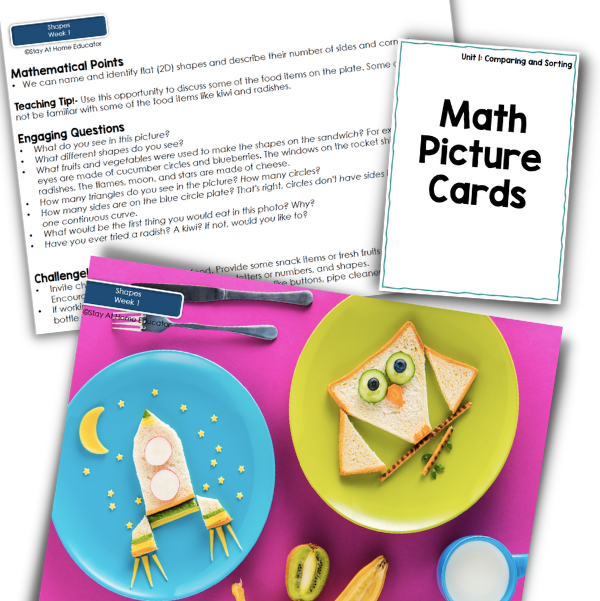
Daily Dip
The daily dip is a review activity to reinforce previously taught skills. You will notice valuable teaching tips throughout the review lessons. These tips offer insight to help execute specific strategies in
the lessons. This section is optional depending on time and student needs but is certainly a valuable component of each day.
The photo below shows examples of the first week of the shapes unit. You’ll notice that the activities include counting, sorting, and matching which were learned in the previous units to ensure exposure and practice to essential math skills all year long.
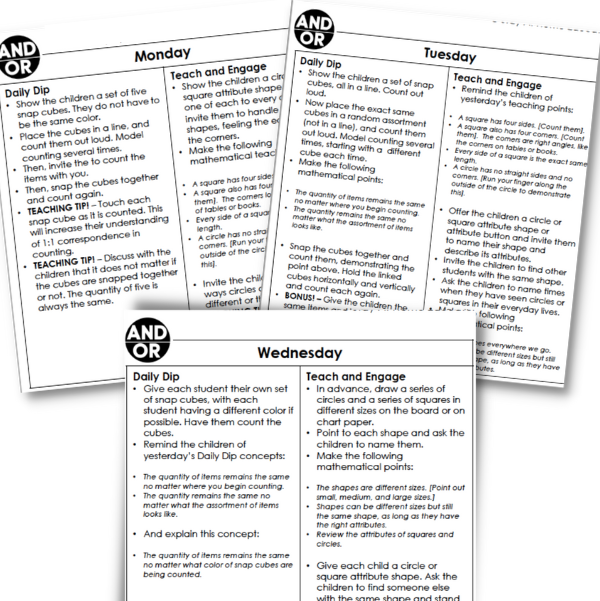
Teach and Engage
The teach and engage section is a brand new daily lesson for your students packed with new learning. This component of the curriculum includes lots of modeling and student interaction.
Each lesson includes a bonus section that offers tips on how to make the lesson more challenging and provides extensions for children who are ready for more difficulty.
Shape Centers for Preschoolers
Shape centers and games are invaluable in preschool. We have included lots of hands-on shape games and math activities for pre-k that allow children to independently practice with engaging manipulatives. Remember independent centers should always be supervised in preschool and kindergarten.
Shape Formation Mats
This center reinforces how to draw the shapes and to make observations about each shape. These shape mats also children with valuable pre-writing skills and pencil grasp development. They can also be used with counters, buttons, pom-poms, or other small items laid along the lines to help with fine motor!
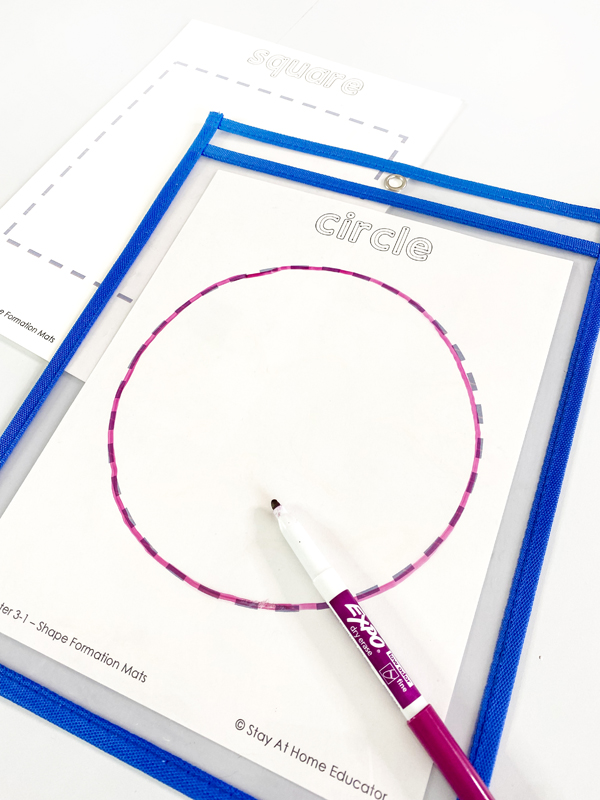
Shape Clip Cards
This center focuses on visual discrimination between basic shapes and colors. The grey shape at the beginning encourages the child to find the matching shapes regardless of color.
This center can also be made self-checking by adding a dot on the back for children to check their work. Add popsicle sticks to this center and encourage children to try and create the focus shape. Are you able to make a circle using popsicle sticks? Why or why not?
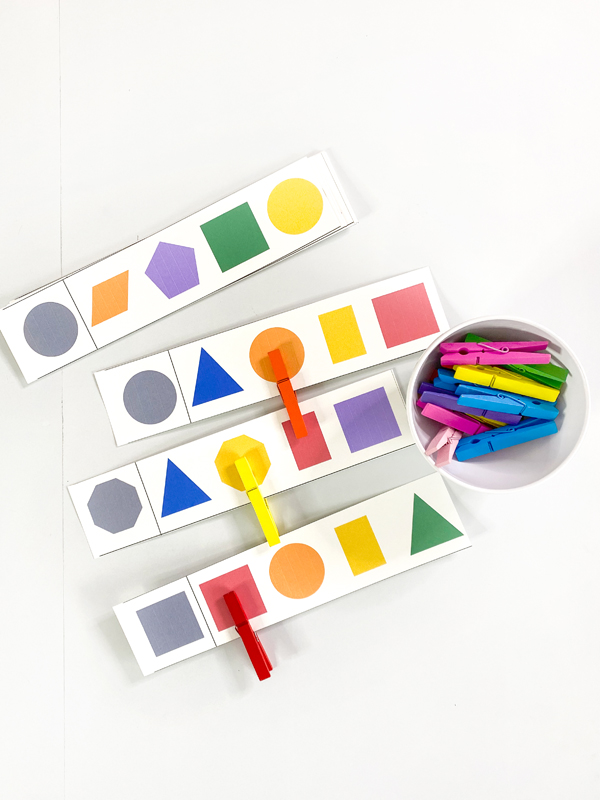
Shape Train
This game is print is such a fun way to learn shapes. Piece the train shapes together to create one long train on the table. Then roll the number and shape die to move your game marker along the train identifying the shapes as you go.
Play continues until each player reaches the end of the train. This center also includes a more complex version with advanced shapes like the rhombus, hexagon, pentagon, etc.
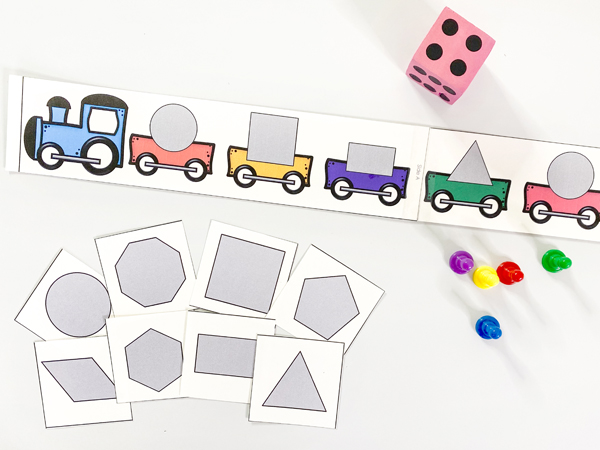
Shape Puzzles
This center is all about the shapes! Children are invited to identify the gray shape and then find the matching puzzle piece with the same colorful shapes. This center is a great opportunity for children to make their own puzzles by drawing the shapes and creating matching pieces.
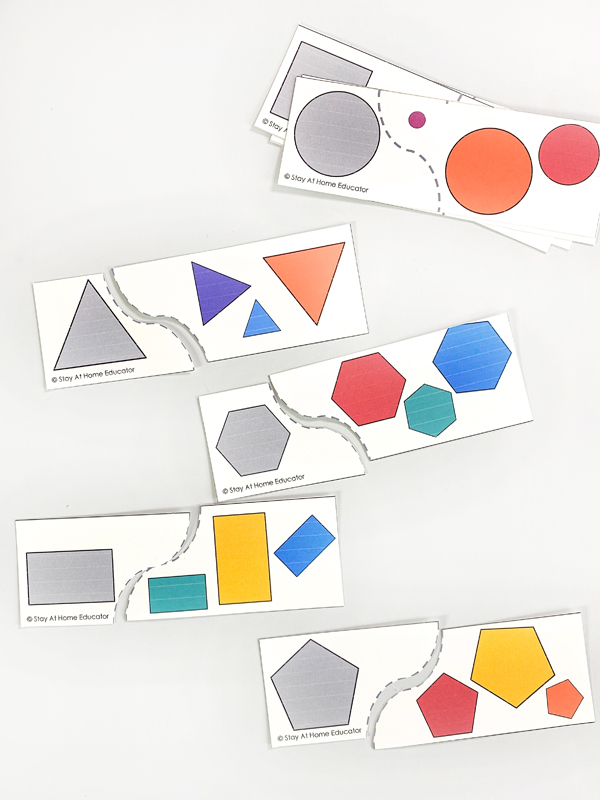
Everyday Shapes I Spy
Put the I Spy mats on a table with counters. Invite the child to choose a shape on the bottom of the mat and put a corresponding colored counter on top of each corresponding everyday shape. Continue until all the everyday shapes have been found.
This center is also easy to differentiate with two versions of each mat, one with the total number of shapes on each mat and one version without.

Shape Playdough Mats
This center is all about the formation of shapes and hands-on fine motor learning. Invite the students to select a shape playdough mat. Encourage them to identify the shape. Then smoosh the playdough onto the shape, making it flat like a pancake, to match the shape.
For more shape practice, add the cut-up straws around the shape, (use yarn for the circle since it has no sides), creating a border/shape outline. This center also provides the opportunity for children to create their own shapes using playdough and identify the sides and corners as well.
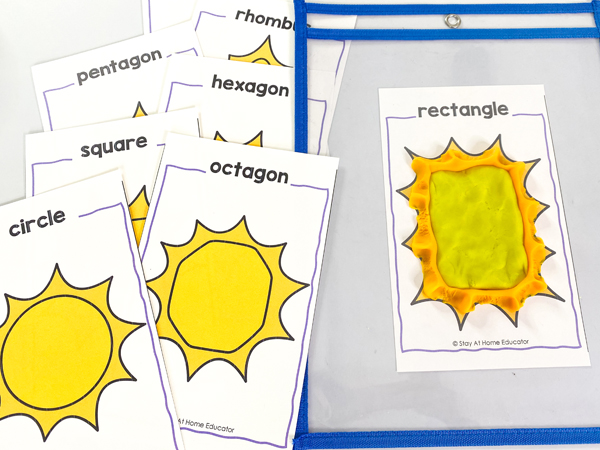
Everyday Shapes Sorting Mats
These everyday shape mats help children make the connection between shape drawings and shapes found in the real world. Mix up the everyday shape cards and set them in a face-down pile next to the sorting mats. Draw an everyday shape card and sort it onto the corresponding shape mat. Continue until all the everyday shape cards are sorted.
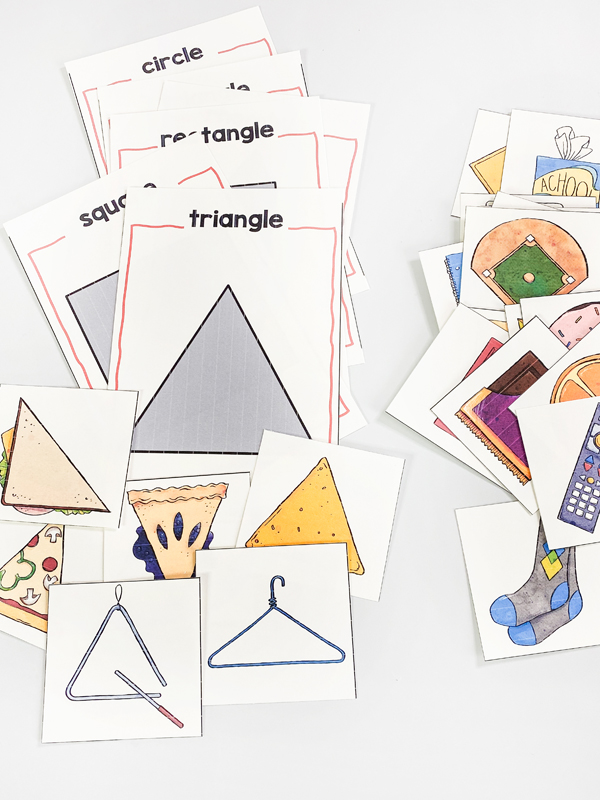
Spin and Cover Everyday Shapes
This spin and cover game is a perfect independent center for practicing shapes in the everyday life! Invite the child to select a spin and cover mat. Once they spin the spinner and identify the shape, they find the corresponding shape on the mat and cover it with a counter.
Play until all the shapes have been covered!
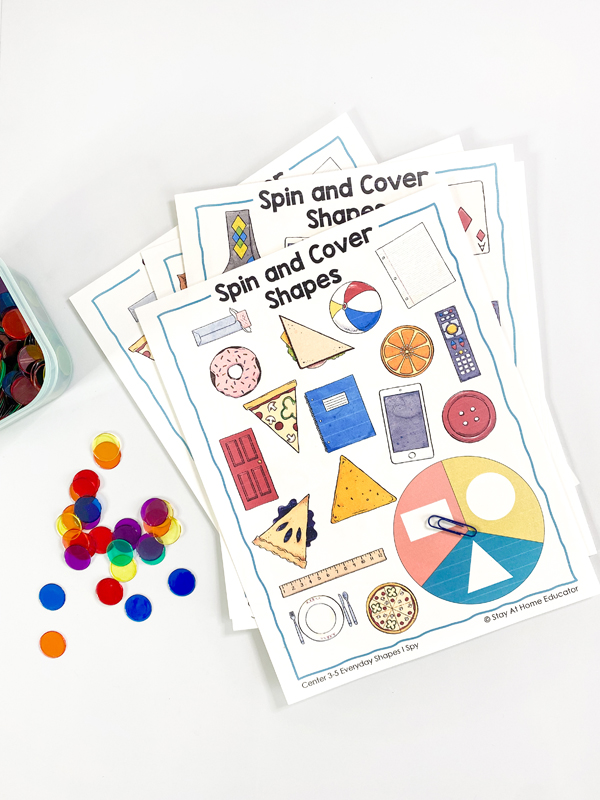
Math to Literacy Connections
We have also included eight optional literacy activities that infuse math picture books. Children learn best through colorful illustrations and storytelling. These eight picture books bring shapes to life and build upon other math skills (counting, colors, patterns) as well.
Grab these fantastic books about shapes here!
- Bear in a Square by Stella Blackstone
- Big Box of Shapes by Wiley Lewis
- Mouse Shapes by Ellen Walsh
- Shape by Shape by Suse MacDonald
- The Shape of Things by Dayle Ann Dodds
- Color Zoo by Lois Ehlert
- Walter’s Wonderful Web by Tim Hopgood
- Round is a Tortilla by Roseanne Thong
- Used Book in Good Condition
- Blackstone, Stella (Author) – Strozier, Henry (Narrator)
- English (Publication Language)
- Blevins, Wiley (Author)
- English (Publication Language)
- 24 Pages – 08/01/2018 (Publication Date) – Red Chair Press (Publisher)
- Walsh, Ellen Stoll (Author)
- English (Publication Language)
- 40 Pages – 09/12/2017 (Publication Date) – Clarion Books (Publisher)
- Dayle Ann Dodds (Author)
- English (Publication Language)
- 32 Pages – 04/20/1996 (Publication Date) – Candlewick Pr (Publisher)
- Ehlert, Lois (Author)
- English (Publication Language)
- 13 Pages – 03/28/1997 (Publication Date) – HarperFestival (Publisher)
- Hardcover Book
- Hopgood, Tim (Author)
- English (Publication Language)
- Thong, Roseanne (Author)
- English (Publication Language)
- 40 Pages – 08/04/2015 (Publication Date) – Chronicle Books (Publisher)
Get Your Shape Lesson Plans for Preschoolers Here
The daily lessons in shapes are completed and ready to use! Filled with daily lesson plans, centers, activities, and even literacy connections, this shape math unit is all you’ll need for your preschool lessons.
Math Lesson Plans for Preschoolers
Creating a comprehensive math lesson plan for preschoolers requires careful consideration and planning. A full math curriculum should encompass all five disciplines in mathematics: number sense, operations, geometry, measurement, and data analysis.
It’s crucial to introduce children to these concepts in a fun and engaging manner. It’s also crucial to teach preschool math systematically. Here are more posts about math lesson plans for preschoolers and how to teach preschool math.
- Shape Preschool Lesson Plans (you are here)
- Counting 0-5 Preschool Lesson Plans
- Comparing & Sorting Preschool Lesson Plans
- Counting 0-10 Preschool Lesson Plans
- Positions & Patterns Preschool Lesson Plans
- Counting 0-20 Preschool Lesson Plans
- Measurement Preschool Lesson Plans
- Graphing Preschool Lesson Plans
- Addition & Subtraction Preschool Lesson Plans
FAQ About Teaching Shapes to Preschoolers
In preschool, children learn to identify and name shapes by using materials such as posters, blocks, games hands-on manipulatives, and books. Learning shapes is a process and requires repetition and practice. Scavenger hunts, shape collages, and sensory bins all help children learn to identify basic shapes.
Shapes are the foundation of geometry! In a preschool setting, geometry skills include identifying shapes, comparing shapes, differentiating between shapes, and creating shapes. Learning shapes provides children with spatial awareness and visual discrimination as they identify different shapes.
There are endless fun pre k shape activities for use in the classroom! We have included eight hands-on center activities and games in our lesson plans that teach shapes to preschoolers. Plus, we have created specific shape photo cards which encourage preschoolers to dive deep into a photograph and make connections to how shapes are all around us.

I’m Sarah, an educator turned stay-at-home-mama of five! I’m the owner and creator of Stay At Home Educator, a website about intentional teaching and purposeful learning in the early childhood years. I’ve taught a range of levels, from preschool to college and a little bit of everything in between. Right now my focus is teaching my children and running a preschool from my home. Credentials include: Bachelors in Art, Masters in Curriculum and Instruction.













